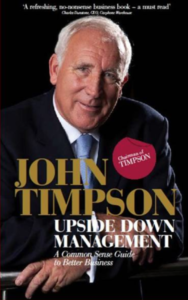- September 17, 2019
- Posted by: andreag
- Category: High PerformanceLeadershipOrg Culture

 Following on from my recent blog regarding John Timpson’s approach to management, I wanted to relay some particular tips and innovative techniques that this highly successful businessman employed to take his organization to its full potential, as well as the pitfalls he tried to avoid. The following are the ones that particularly caught my attention.
Following on from my recent blog regarding John Timpson’s approach to management, I wanted to relay some particular tips and innovative techniques that this highly successful businessman employed to take his organization to its full potential, as well as the pitfalls he tried to avoid. The following are the ones that particularly caught my attention.
First the techniques to try:
-
- Trust
A common mistake I have seen over the years is executives defining restrictive policies in response to conduct of a very small percentage of their employees. The effect is to reduce freedom/innovation/morale of all in an effort to deter very few. Timpson talks about this in terms of how to deal with employees stealing from the till at his stores. He writes the following: “Suspicion is expensive, and every attempt to tighten security costs money. I have found it much cheaper to trust everybody…I refuse to design a system around the 2% who are dishonest. I’d much rather give everyone else freedom so that the 98% honest people are encouraged to make me more money,” - Keep Going Round the Business
Management by walking or wandering around first surfaced as a management technique by Hewlett Packard in 1970. The concept was popularized by Tom Peters and Robert Waterman in their 1982 book, In Search of Excellence. The idea is that by randomly sampling employees by unscheduled direct discussion, managers will learn and implement ideas to improve morale, productivity and quality. This technique replaces formal and scheduled meetings with groups. Timpson adopted a practice of spending 2 days per week visiting his shops, noting that PDA’s make it possible for you to run your business from anywhere. Timpson also adopted a practice of barging into meetings, most of which he found “big time wasters”. No doubt his random visits made them more productive across the company. - Resist consultants but have a guru
From reading Timpson, I would say that “guru” translates to coach, be that person a friend/peer or a paid person with whom you can entrust problems, get feedback on solutions etc. Timpson views consulting as the hiring of someone to do the work that the CEO him or herself should be doing, specifically define strategy. Obviously, I have a bit of a biased view here as much of my business focuses on strategic planning, but I would counter him with the following points: 1) methodology and the design/quality of tools that come out of strategic thinking can make a meaningful difference. Hiring someone with a proven methodology and tools can reduce the time required to develop a plan, thereby adding value, 2) organizations struggle to learn and confront the truth about what is holding them back from a higher level and 3) not involving employees takes out of the process eyes and ears that are closest to customers and most impacted by inefficient/ineffective methods. For such organizations, an outside facilitator can uncover that truth and make it safe for management to face and solve it. Timpson has created an unusual organizational culture that fosters two-way communication with employees, empowers employees to innovate and challenges management to feel and respond to the pulse of both employees and customers. The odds of a successful strategic plan developed by the CEO in such a culture are higher than normal. For others, I recommend weighing the value a consultant can bring.
- Trust
Next are what Timpson refers to as “signs of a second-rate CEO”. In addition to offering advice on how to get it right, Timpson offers observations of the traps CEO’s can fall into that lead to their undoing.
-
 Back-to-back meetings
Back-to-back meetings
Timpson considers these a sign of ineffective delegation and not “getting around” or knowing the business. The impact is that the CEO is left with no time to plan the future, the #1 job of a CEO.- Stubbornness
This is the inability to see or act on the need to change policy or strategy. It stems from a need to be right. As Ken Blanchard famously said, “Give up being right, you’ll end up dead right”. Listen to and act upon what you learn from employees and customers to evaluate whether the current policy and plan are working. Then have the courage to change or get off what is not working. - Faith in foolish people
He defines this as continuing to hold on to people in senior positions who block progress. “These people have no respect for the rest of the workforce and make a major contribution to the company’s failure.” - The empire builder
Defined as an exec who has fallen prey to prioritizing the size of his/her office or make of car. - Becoming the consultant’s friend
See above for a rebuttal of sorts to this one. But Timpson is correct that consultants can be used to a disadvantage. The warning sign is that the first action of the CEO is to bring in an outsider before assessing the abilities of staff. - Short-term cost cutting
His take is that this leads to short-term gains but can derail long-term success. - Top-down communications
By this he means cascading down of memos through the organization. There is no replacement, in his view, for face to face meetings with employees. - Appraisals
I am pleased to say that Timpson’s experience supports the recommendations in my book, Creating High Performers regarding performance reviews. Timpson left the company for some time and then returned. While he was gone, the company introduced an appraisal system. “For the next three years appraisal reviews filled my diary. In my keenness to be fair and balanced, I found ways to praise the poorest people and looked for something that good people could do better. I can’t remember one interview that brought any benefit and I suspect some did quite a lot of harm. We abandoned appraisals 25 years ago and have survived happily ever since. …We now let managers review progress with colleagues in whatever way they wish…Face-to-face praise or criticism shouldn’t wait for an appraisal, its better done there and then with a heart-to-heart chat…Although we don’t encourage formal appraisals; everyone can raise problems and talk about their future with their boss.” Note the emphasis: it’s the employee talking and the boss listening.
If this feels a bit like more warnings than tips, well, it is. But within each sign of a second rate CEO is its opposite, which when followed can create a high caliber leader.
My thanks to my friend, Mark Barton, owner/proprietor of The Milton Inn in Monifieth, Scotland for the gift of Timpson’s book and to John Timpson for demonstrating that management practice based on trust of employees and common sense can lead to huge success.
Any thoughts? We would enjoy hearing from you. Drop us an email to join the conversation!



